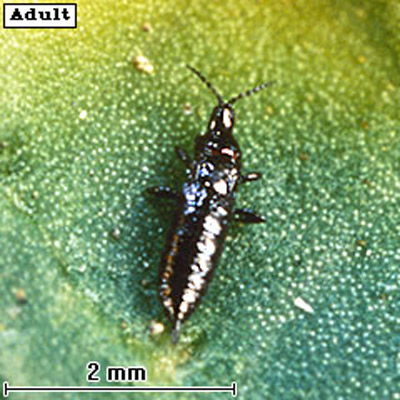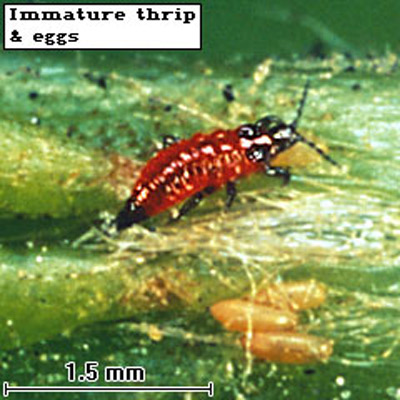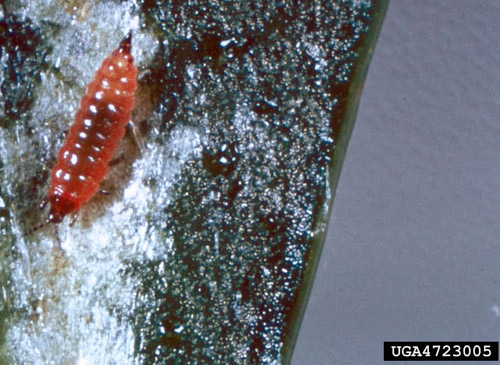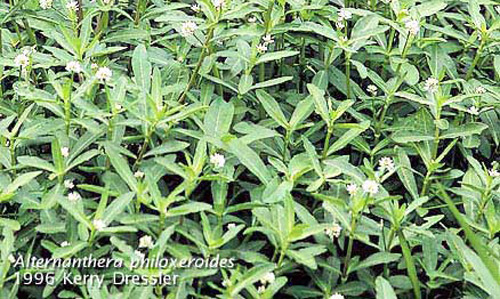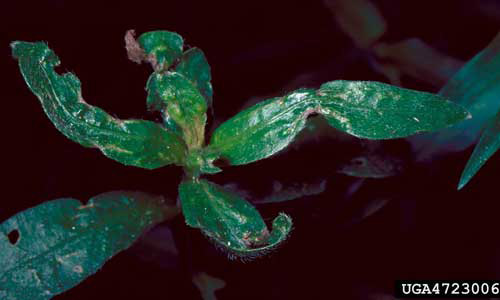common name: alligatorweed thrips (suggested)
scientific name: Amynothrips andersoni O'Neill (Insecta: Thysanoptera: Phlaeothripidae)
Introduction - Distribution - Description - Life Cycle - Hosts - Economic Importance - Selected References
Introduction (Back to Top)
Alligatorweed, Alternanthera philoxeroides (Mart.) Griseb. (Amaranthaceae), is an aquatic weed native to South America that began threatening Florida's waterways in the early 1900s (Langeland et al. 2008). This rooted perennial herb reproduces vegetatively from stem fragments and forms dense floating mats. The floating mats impede navigation, block drains and water intake valves, reduce light penetration, and displace native species (Langeland et al. 2008).
The alligatorweed thrips, Amynothrips andersoni O'Neill, was the second South American natural enemy of this aquatic weed imported into the United States. The alligatorweed flea beetle was the first one. The alligatorweed thrips was released in Florida, Georgia, South Carolina, and California for biological control of alligatorweed in 1967. Subsequent releases occurred in Texas and Mississippi in 1968 (Center et al. 2002, Grodowitz and Whitaker 2005).
Figure 1. A short-winged (brachypterous) adult alligatorweed thrips, Amynothrips andersoni O'Neill. Photograph by U.S. Army Engineer Research and Development Center, Vicksburg, MS.
Distribution (Back to Top)
Native to South America, the alligatorweed thrips is established across the southern United States, including Alabama, Florida, Georgia, Louisiana, Mississippi, South Carolina, and Texas. Establishment in California has not been confirmed (Center et al. 2002, Grodowitz and Whitaker 2005).
Description (Back to Top)
Adults: Alligatorweed thrips adults are shiny and black in color. Females are only about 2.1 mm long, whereas males are about 1.7 mm long. Two forms exist, a brachypterous (short-winged) form and a macropterous (long-winged) form. Only the macropterous form is capable of flight (Center et al. 2002, Grodowitz and Whitaker 2005).
Eggs: The eggs are laid singly and are yellowish or amber in color when deposited, but turn red as the embryos mature. Egg development is completed in about seven days (Center et al. 2002).
Figure 2. Second instar (deep red in color with black legs) and yellowish eggs (foreground) of the alligatorweed thrips, Amynothrips andersoni O'Neill. Photograph by U.S. Army Engineer Research and Development Center, Vicksburg, MS.
Larvae: There are two distinct larval instars. The first instar (length 0.6 to 0.7 mm) is light gray at first, becoming amber as it matures. The second instar (length 1.3 to 1.9 mm) is deep red with black legs (Center et al. 2002).
Figure 3. Second instar (deep red in color with black legs) of the alligatorweed thrips, Amynothrips andersoni O'Neill. Photograph by USDA ARS, Bugwood.org.
Pupae: As with other species of thrips in the family Phlaeothripidae, development of the alligatorweed thrips progresses through three pupal instars; a propupa, followed by pupal instars 1 and 2 (Center et al. 2002).
Life Cycle (Back to Top)
Females undergo a 4-day preovipositional period after which they deposit their eggs on or behind hairs present in leaf axils on stem nodes of alligatorweed. Each female lays an average of 200 eggs (Center et al. 2002, Grodowitz and Whitaker 2005).
Larvae are active feeders, piercing the meristematic tissues (new growth) of the alligatorweed plant with stylets (rod-like structures) formed from the mandibles and maxillae (mouthparts). The total generation time is about 28 days, and the adults live up to four months. Females probably are facultatively parthenogenetic, i.e., unmated females will produce haploid males (Center et al. 2002, Grodowitz and Whitaker 2005).
Hosts (Back to Top)
The thrips feeds only on alligatorweed, Alternanthera philoxeroides (Mart.) Griseb. (Amaranthaceae).
Figure 4. Dense stand of alligatorweed, Alternanthera philoxeroides (Mart.) Griseb. Photograph by Kerry Dressler, Center for Aquatic and Invasive Plants, University of Florida.
Economic Importance (Back to Top)
On floating alligatorweed, the thrips has difficulty competing with the alligatorweed flea beetle which rapidly defoliates the plants. However, the thrips thrives on rooted alligatorweed, that is usually not heavily attacked by the flea beetle.
Thrips damage is restricted primarily to new growth, e.g., leaf buds, new leaves, and young flowers. Scarified lesions are produced along the margins of the young leaves, causing the leaves to distort and curl. The larvae often aggregate within these curled leaves, which provide excellent hiding and feeding sites. The feeding activity of the larvae causes stunting of leaf growth, but thrips populations are sporadic and their distribution seems limited. Of the three insects (alligatorweed thrips, alligatorweed flea beetle, and stem boring moth) released for biological control of alligatorweed, the thrips is the most cold tolerant. Some evidence indicates that predators may suppress thrips populations, as does resource competition from flea beetles (Center et al. 2002, Grodowitz and Whitaker 2005).
Infested plants exhibit damage similar to plants that have been treated with the herbicide 2,4-D: the leaves appear to be curled and highly folded. Because feeding by alligatorweed thrips is almost entirely on the newest portion of the plant, they continually prevent the production of healthy functional leaves. This in turn reduces the ability of the plant to produce photosynthate (food), significantly weakening it over time. However, the effect of this insect on alligatorweed, particularly the rooted form, has never been fully evaluated (Grodowitz and Whitaker 2005).
Figure 5. Leaf distortion on alligatorweed, Alternanthera philoxeroides (Mart.) Griseb. is characteristic of feeding by adults and larvae of the alligatorweed thrips, Amynothrips andersoni O'Neill. Photograph by Gary Buckingham, USDA Agricultural Research Service, retired; Bugwood.org.
Selected References (Back to Top)
- Center TD (retired), Dray Jr FA, Jubinsky GP, Grodowitz MJ. 2002. Insects and Other Arthropods That Feed on Aquatic and Wetland Plants. U.S. Department of Agriculture, Agricultural Research Service, Technical Bulletin No. 1870.
- Grodowitz MJ, Whitaker, SL. (2005). Amynothrips andersoni - Alligatorweed Thrips, Aquatic Plant Information System (APIS), Engineer Research and Development Center, U.S. Army Corps of Engineers, Vicksburg, MS. (4 April 2013).
- Langeland KA, Cherry HM, McCormick CM, Craddock Burks KA. 2008. Identification and Biology of Nonnative Plants in Florida's Natural Areas, 2nd Edition. SP 257. University of Florida/IFAS, Gainesville. 210 pp.
- [UF/IFAS] University of Florida/IFAS. (2009). Alligator weed, Alternanthera philoxeroides. Center for Aquatic and Invasive Plants. (4 April 2013).
